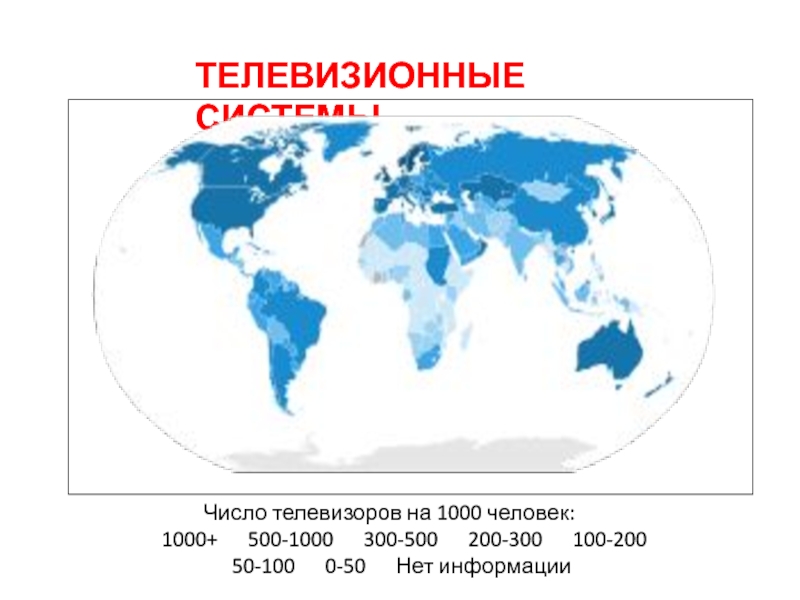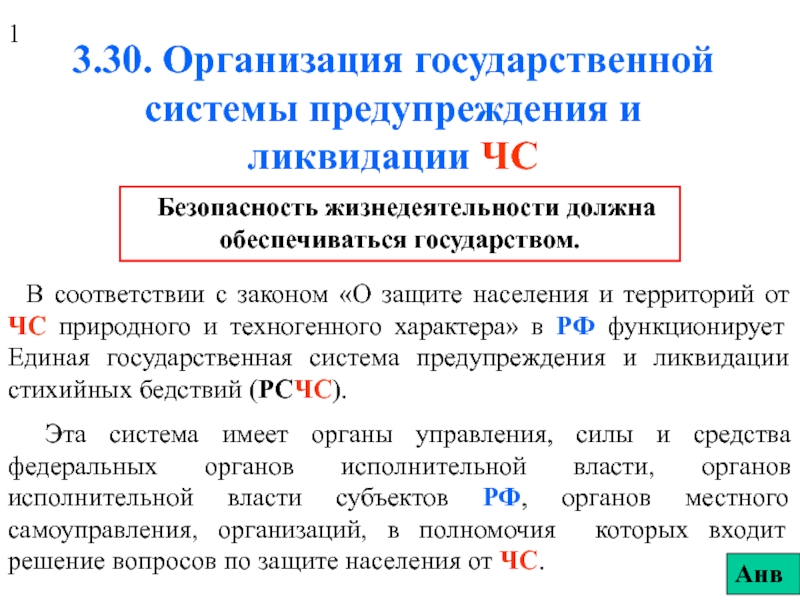Разделы презентаций
- Разное
- Английский язык
- Астрономия
- Алгебра
- Биология
- География
- Геометрия
- Детские презентации
- Информатика
- История
- Литература
- Математика
- Медицина
- Менеджмент
- Музыка
- МХК
- Немецкий язык
- ОБЖ
- Обществознание
- Окружающий мир
- Педагогика
- Русский язык
- Технология
- Физика
- Философия
- Химия
- Шаблоны, картинки для презентаций
- Экология
- Экономика
- Юриспруденция
В.В. Подбельский Иллюстрации к курсу лекций по дисциплине Программирование С
Содержание
- 1. В.В. Подбельский Иллюстрации к курсу лекций по дисциплине Программирование С
- 2. 19.1. Стек для чисел class MyFloatStack //
- 3. 19-2. Generic types are templates for types
- 4. 19-3. Generics and user-defined types
- 5. 19-4. Continuing with the Stack Example class
- 6. 19-5. Creating instances from a generic type
- 7. 19-6. Declaring a Generic Class Type parameters
- 8. 19-7. Creating a Constructed Type
- 9. 19-8. Type parameters versus type arguments
- 10. 19-9. Creating Variables and InstancesMyNonGenClass myNGC =
- 11. 19-10.
- 12. 19-11. Two constructed classes created from a generic class
- 13. 19-12. Constraints on Type Parameters class Simple{static
- 14. 19-13. Where ClausesType parameter Constraint list ↓ ↓where
- 15. 19-14. Constraint Types and Order
- 16. 19-15. If a type parameter has multiple constraints, they must be in this order.
- 17. 19-16. Правила задания ограниченийclass SortedList where S: IComparable
- 18. 19-17. Generic Structsstruct PieceOfData // Generic struct{ public
- 19. 19-18. Generic Structs class Program {static void Main()
- 20. 19-19. Generic Interfaces Type parameter
- 21. 19-20. Generic Interfaces class Program{static void Main(){ var
- 22. 19-21. Using Generic Interfaces interface IMyIfc //
- 23. 19-22. Using Generic Interfaces class Program {static void
- 24. 19-23. Duplicate interface interface IMyIfc { T ReturnIt(T
- 25. 19-24. Generic Delegates Type parameters ↓delegate R MyDelegate(
- 26. 19-25. Generic delegate and matched delegate methodsdelegate
- 27. 19-26. Generic Delegate class Program {static void Main(
- 28. 19-27. Generic Delegate public delegate TR Func(T1
- 29. 19-28. Generic Methods
- 30. 19-29. Declaring a Generic Method Type parameter
- 31. 19-30. Invoking a Generic Method Объявление обобщенного метода:void MyMethod() { T1 someVar; T2 otherVar; …} Type arguments ↓ MyMethod(); MyMethod();
- 32. 19-31. A generic method with two instantiations
- 33. 19-32. Inferring Types public void MyMethod (T
- 34. 19-33. Example of a Generic Method class
- 35. 19-34. Example of a Generic Method class
- 36. 19-35. Extension Methods with Generic Classes static
- 37. 19-36. Exampleclass Program {static void Main(string[] args) { var
- 38. 19-37.
- 39. Скачать презентанцию
19.1. Стек для чисел class MyFloatStack // Stack for floats{int StackPointer = 0;float [] StackArray; // Array of float ↑ floatfloat ↓public void
Слайды и текст этой презентации
Слайд 1В.В. Подбельский Иллюстрации к курсу лекций по дисциплине «Программирование» С#_19 Generics Использованы материалы
пособия Daniel Solis, Illustrated C# 2008.
Слайд 219.1. Стек для чисел
class MyFloatStack // Stack for floats
{
int
StackPointer = 0;
float [] StackArray; // Array of float
↑
floatfloat ↓
public void Push( float x ) // Input type: float
{... }
float
↓
public float Pop() // Return type: float
{...}
...
}
Слайд 519-4. Continuing with the Stack Example
class MyStack
{
int StackPointer
= 0;
T [] StackArray;
public void Push(T x ) {...}
public T
Pop() {...}...
}
Слайд 719-6. Declaring a Generic Class
Type parameters
↓
class SomeClass
T1, T2 >
{ Normally, types would be used in these
positions.↓ ↓
public T1 SomeVar = new T1();
public T2 OtherVar = new T2();
} ↑ ↑
Normally, types would be used in these positions.
Слайд 1019-9. Creating Variables and Instances
MyNonGenClass myNGC = new MyNonGenClass ();
Constructed
class Constructed class
↓ ↓
SomeClass mySc1 = new SomeClass();
var
mySc2 = new SomeClassСлайд 1319-12. Constraints on Type Parameters
class Simple
{
static public bool LessThan(T
i1, T i2)
{
return i1 < i2; // Error
}
...
}
Слайд 1419-13. Where Clauses
Type parameter Constraint list
↓ ↓
where TypeParam : constraint,
constraint, ...
↑
Colon
nbounded With constraints↓ ↓ No separators
class MyClass < T1, T2, T3 > ↓
where T2: Customer // Constraint for T2
where T3: Icomparable // Constraint for T3
{ ↑
... No separators
}
Слайд 1719-16. Правила задания ограничений
class SortedList
where S: IComparable { ... }
class
LinkedList
where M : IComparable
where N : ICloneable { ... }
class
MyDictionarywhere KeyType : IEnumerable,
new() { ... }
Слайд 1819-17. Generic Structs
struct PieceOfData // Generic struct
{
public PieceOfData(T value) {
_Data = value; }
private T _Data;
public T Data
{
get { return
_Data; }set { _Data = value; }
}
}
Слайд 1919-18. Generic Structs
class Program {
static void Main() Constructed type
{ ↓
var
intData = new PieceOfData(10);
var stringData = new PieceOfData("Hi there.");
↑
Constructed type
Console.WriteLine("intData
= {0}", intData.Data);Console.WriteLine("stringData = {0}", stringData.Data);
}
}
Слайд 2019-19. Generic Interfaces
Type parameter
↓
interface IMyIfc //
Generic interface
{ T ReturnIt(T inValue); }
Type parameter Generic interface
↓
↓class Simple
{
public S ReturnIt(S inValue) // Implement interface
{ return inValue; }
}
Слайд 2119-20. Generic Interfaces
class Program{
static void Main(){
var trivInt = new
Simple();
var trivString = new Simple();
Console.WriteLine("{0}", trivInt.ReturnIt(5));
Console.WriteLine("{0}", trivString.ReturnIt("Hi there."));
}
}
This code produces
the following output:5
Hi there.
Слайд 2219-21. Using Generic Interfaces
interface IMyIfc // Generic interface
{ T ReturnIt(T
inValue); }
Two different interfaces from the same generic interface
↓ ↓
class Simple :
IMyIfc{
public int ReturnIt(int inValue) / / Implement int interface
{ return inValue; }
public string ReturnIt(string inValue) // Implement string interface
{ return inValue; }
}
Слайд 2319-22. Using Generic Interfaces
class Program {
static void Main() {
Simple trivInt =
new Simple();
Simple trivString = new Simple();
Console.WriteLine("{0}", trivInt.ReturnIt(5));
Console.WriteLine("{0}", trivString.ReturnIt("Hi there."));
}
}
This code
produces the following output:5
Hi there.
Слайд 2419-23. Duplicate interface
interface IMyIfc { T ReturnIt(T inValue); }
class Simple :
IMyIfc, IMyIfc { // Error!
public int ReturnIt(int inValue)
// Implement first interface.{ return inValue; }
public S ReturnIt(S inValue) // Implement second interface,
{ return inValue; } // but if it's int, it would be
// the same as the one above.
}
Слайд 2519-24. Generic Delegates
Type parameters
↓
delegate R MyDelegate( T value
);
↑ ↑
Return
type Delegate formal parameterСлайд 2619-25. Generic delegate and matched delegate methods
delegate void MyDelegate(T value);
// Generic delegate
class Simple {
static public void PrintString(string s)
{ Console.WriteLine(s); }
static
public void PrintUpperString(string s) { Console.WriteLine("{0}", s.ToUpper()); }
}
Слайд 2719-26. Generic Delegate
class Program {
static void Main( ) {
var myDel =
// Create inst of delegate
new MyDelegate(Simple.PrintString);
myDel += Simple.PrintUpperString; // Add
a method.myDel("Hi There."); // Call delegate
}
}
This code produces the following output:
Hi There.
HI THERE.
Слайд 2819-27. Generic Delegate
public delegate TR Func(T1 p1,
T2 p2);
class Simple {
static public string PrintString(int p1, int
p2) { int total = p1 + p2; return total.ToString(); }
}
class Program {
static void Main() {
var myDel = new Func
Console.WriteLine("Total: {0}", myDel(15, 13));
}
}
Слайд 3019-29. Declaring a Generic Method
Type parameter list Constraint clauses
↓ ↓
public void PrintData
T> ( S p ) where S: Person{ ↑
…. Method parameter list
}
Слайд 3119-30. Invoking a Generic Method
Объявление обобщенного метода:
void MyMethod() {
T1 someVar;
T2
otherVar;
…
}
Type arguments
↓
MyMethod();
MyMethod();
Слайд 3319-32. Inferring Types
public void MyMethod (T myVal) {
... }
↑ ↑
Both are
of type Tint MyInt = 5;
MyMethod
↑ ↑
Both are ints
MyMethod(MyInt);
Слайд 3419-33. Example of a Generic Method
class Simple { // Non-generic
class
static public void ReverseAndPrint(T[] arr) // Generic method
{
Array.Reverse(arr);
foreach (T item
in arr) // Use type argument T.Console.Write("{0}, ", item.ToString());
Console.WriteLine("");
}
}
Слайд 3519-34. Example of a Generic Method
class Program {
static void Main() {
var
intArray = new int[] { 3, 5, 7, 9, 11
};var stringArray = new string[] { "first", "second", "third" };
var doubleArray = new double[] { 3.567, 7.891, 2.345 };
Simple.ReverseAndPrint
Simple.ReverseAndPrint(intArray); // Infer type and invoke
Simple.ReverseAndPrint
Simple.ReverseAndPrint(stringArray);
Simple.ReverseAndPrint
Simple.ReverseAndPrint(doubleArray);
}
}
Слайд 3619-35. Extension Methods with Generic Classes
static class ExtendHolder {
public static
void Print(this Holder h) {
T[] vals = h.GetValues();
Console.WriteLine("{0},\t{1},\t{2}", vals[0],
vals[1], vals[2]); }}
class Holder
T[] Vals = new T[3];
public Holder(T v0, T v1, T v2)
{ Vals[0] = v0; Vals[1] = v1; Vals[2] = v2; }
public T[] GetValues() { return Vals; }
}
Слайд 3719-36. Example
class Program {
static void Main(string[] args) {
var intHolder = new
Holder(3, 5, 7);
var stringHolder = new Holder("a1", "b2", "c3");
intHolder.Print();
stringHolder.Print();
}
}
This code
produces the following output:3, 5, 7
a1, b2, c3

![В.В. Подбельский Иллюстрации к курсу лекций по дисциплине Программирование С 19.1. Стек для чисел class MyFloatStack // Stack for floats{int StackPointer 19.1. Стек для чисел class MyFloatStack // Stack for floats{int StackPointer = 0;float [] StackArray; // Array](/img/tmb/4/304364/e76084327286034c899a570c1e8966c8-800x.jpg)
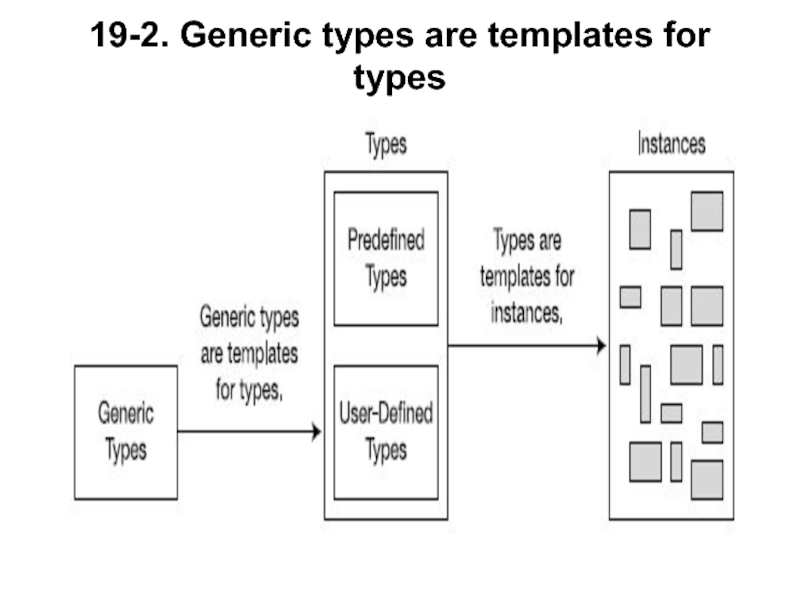
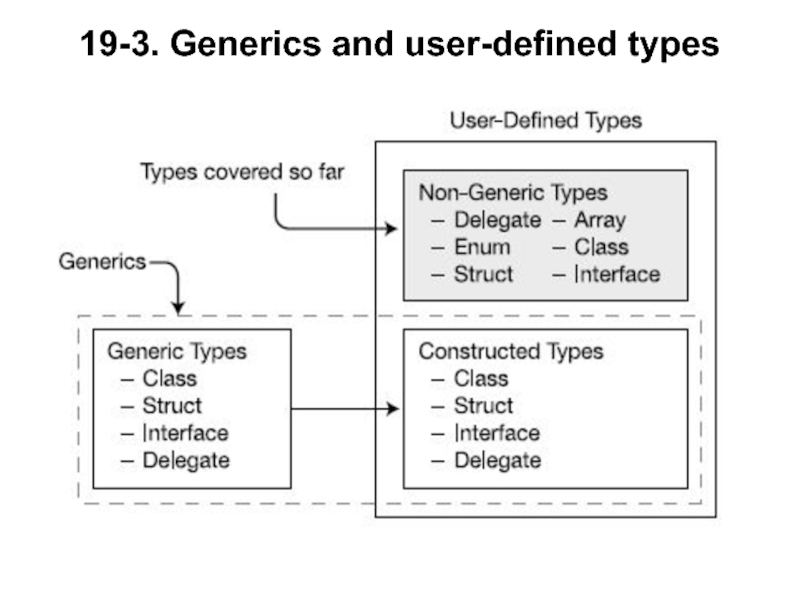
![В.В. Подбельский Иллюстрации к курсу лекций по дисциплине Программирование С 19-4. Continuing with the Stack Example class MyStack { int StackPointer = 19-4. Continuing with the Stack Example class MyStack { int StackPointer = 0; T [] StackArray; public void Push(T x](/img/thumbs/e3b2c56bc555dc39e8597ccaa91ebcce-800x.jpg)
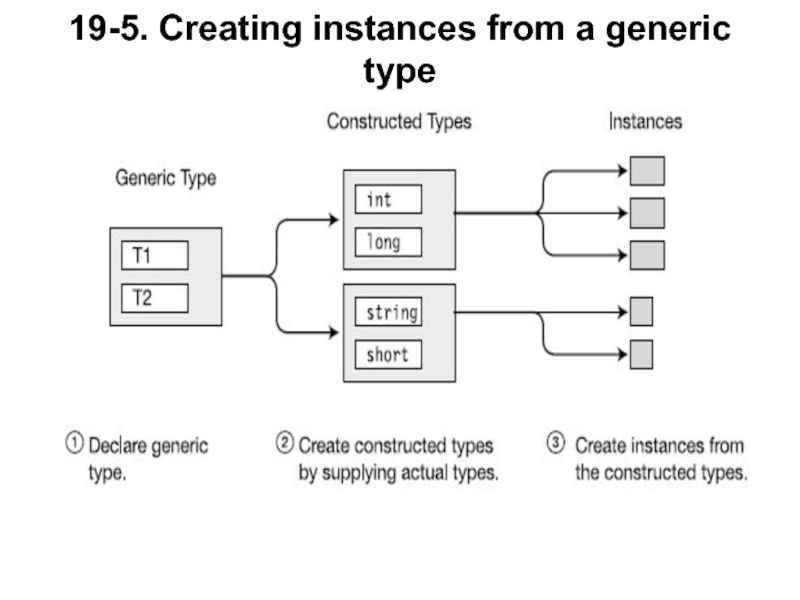
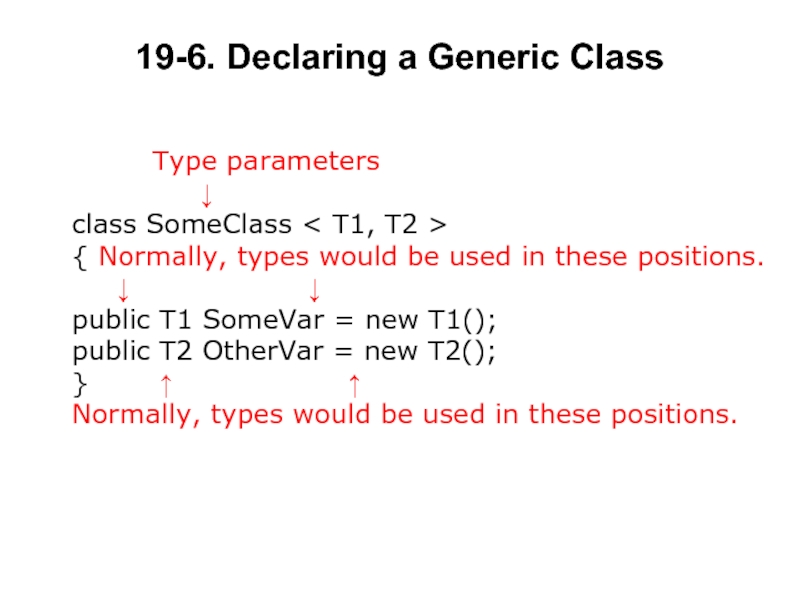
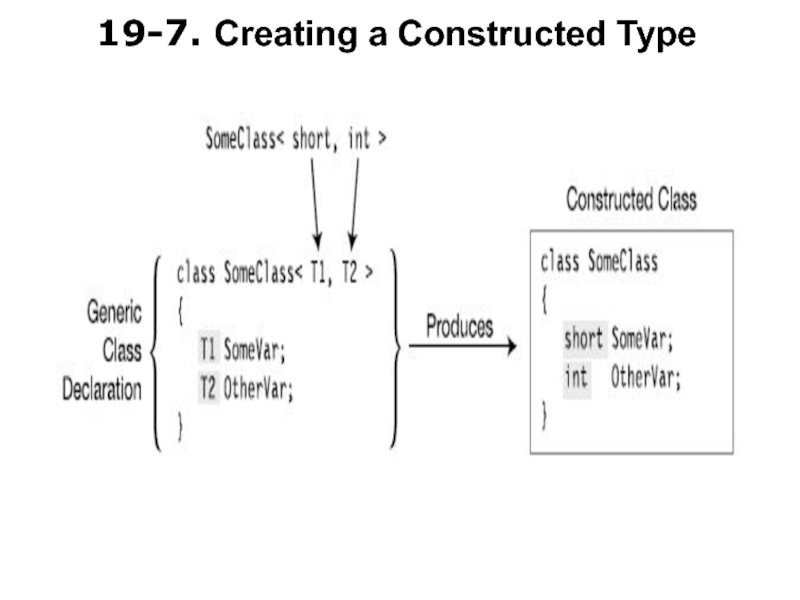
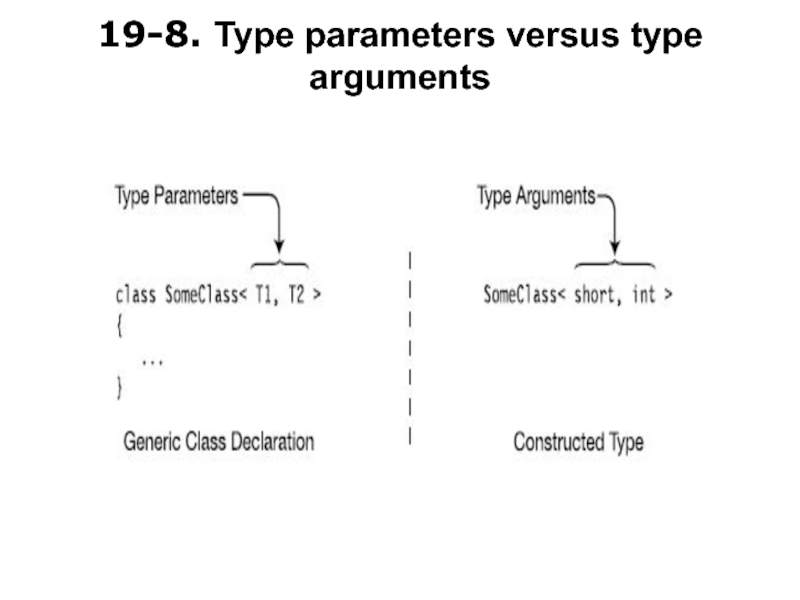
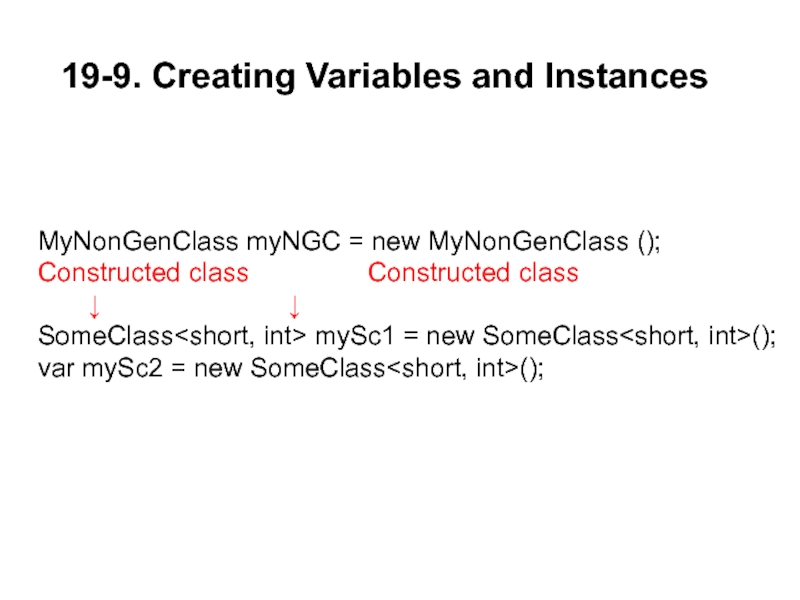
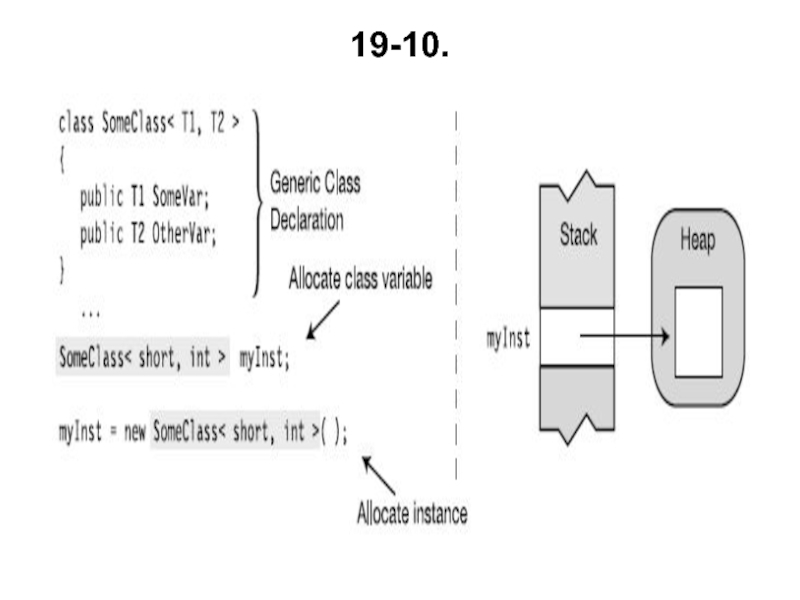
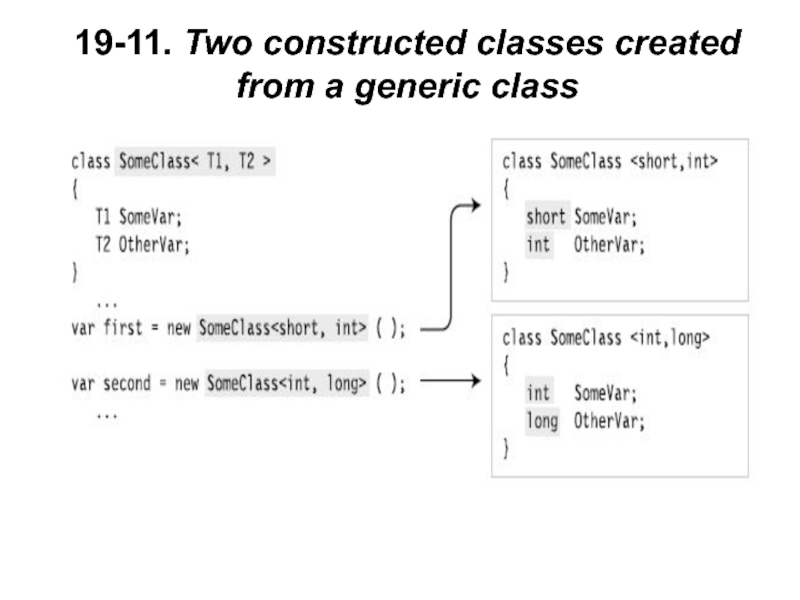
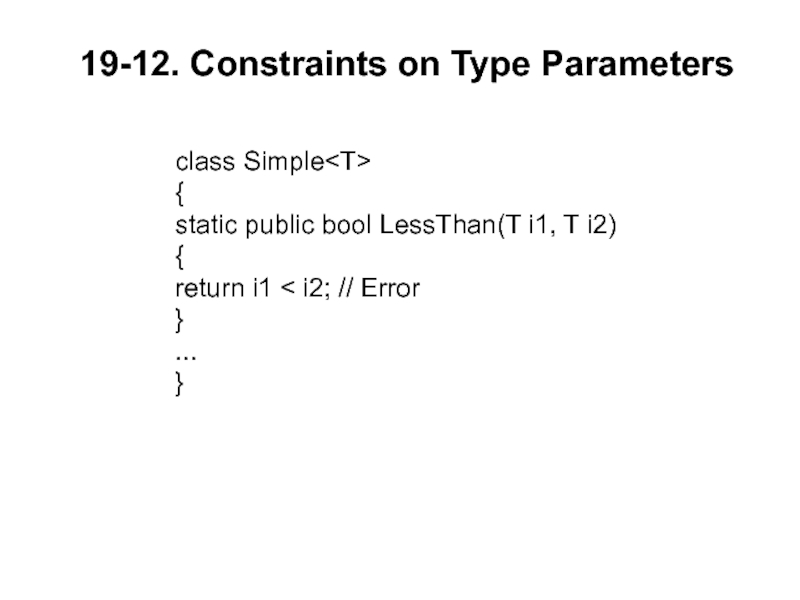
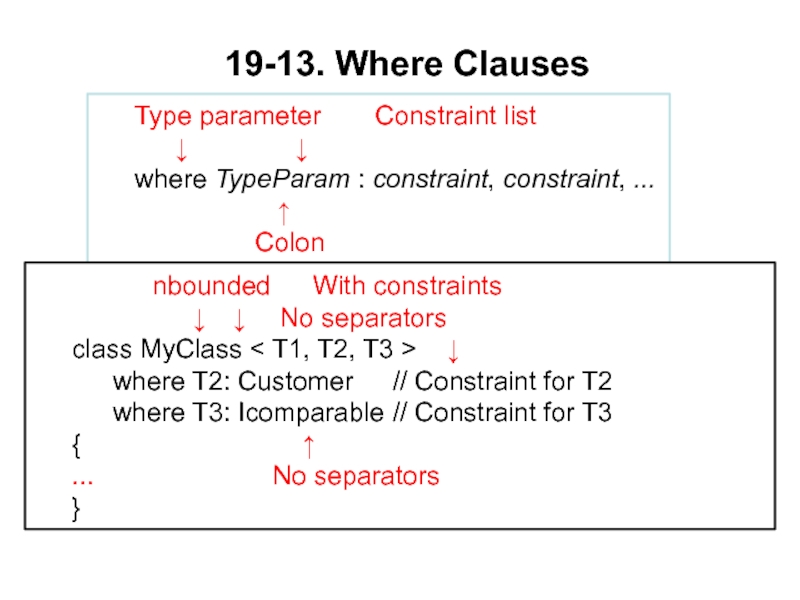
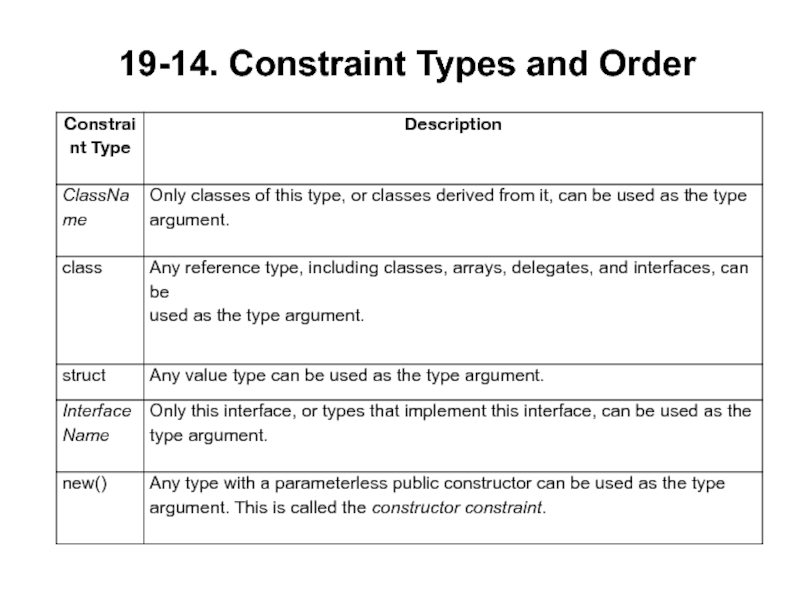
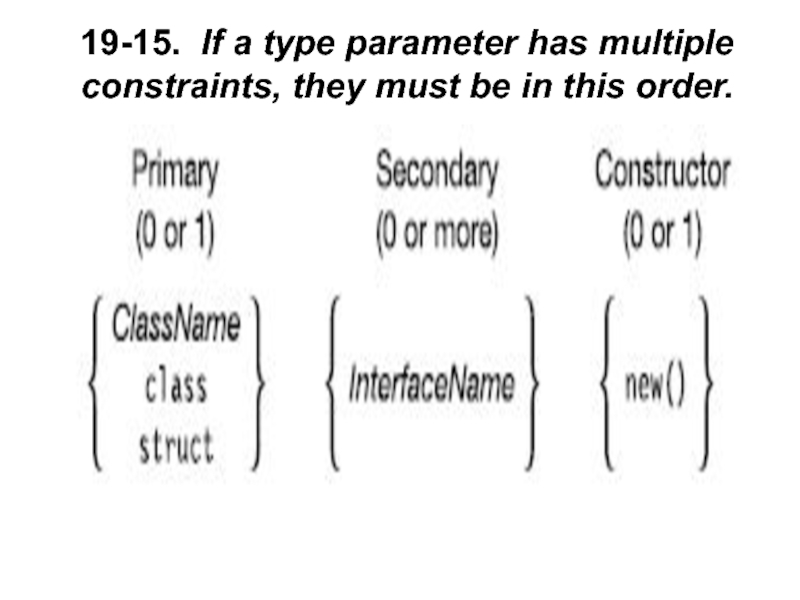
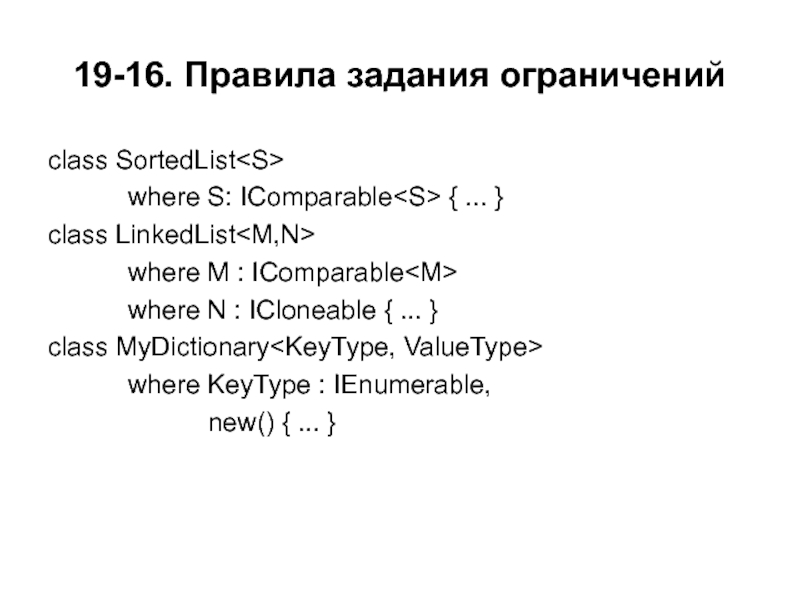
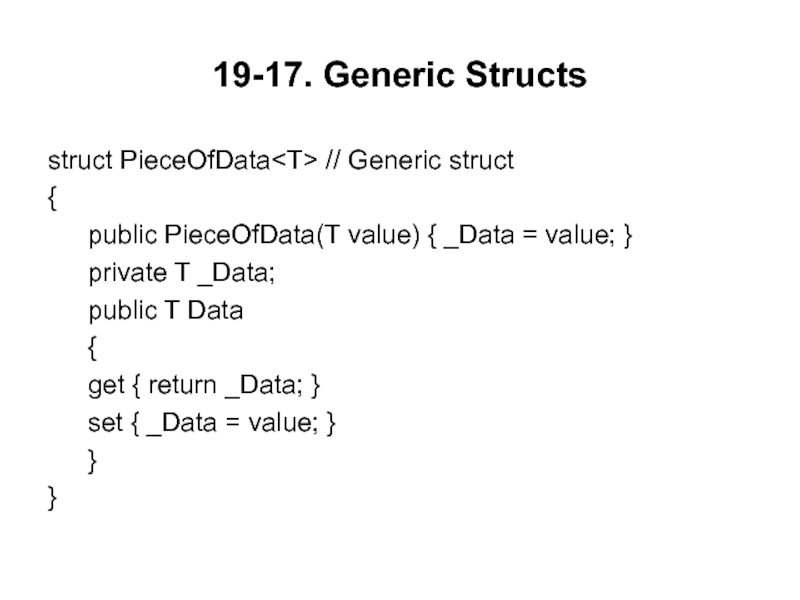
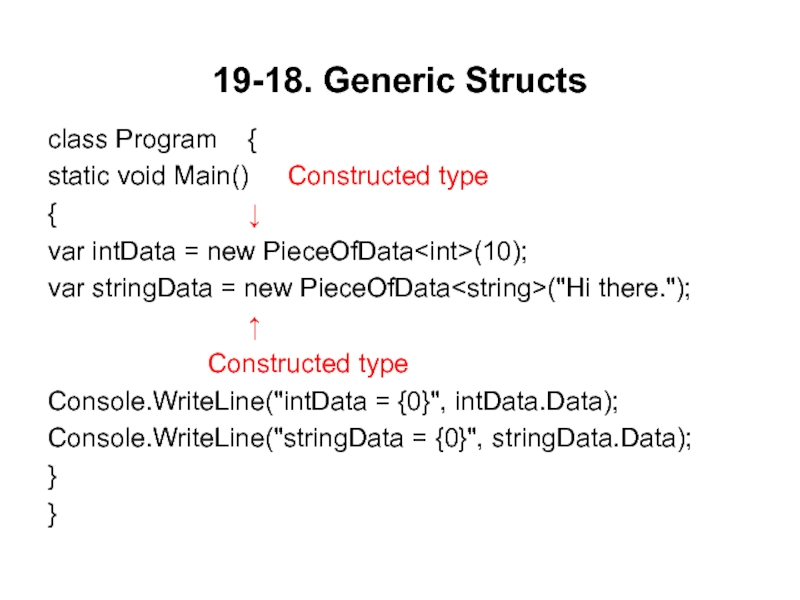
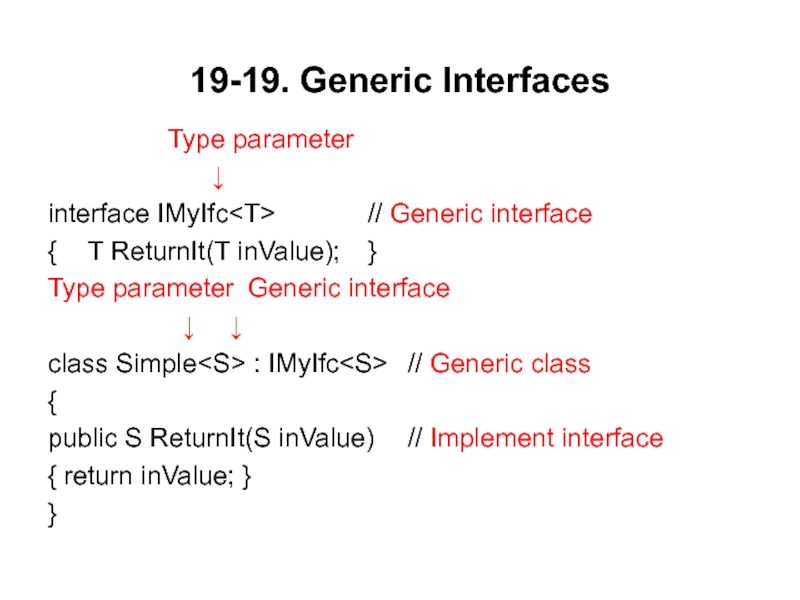
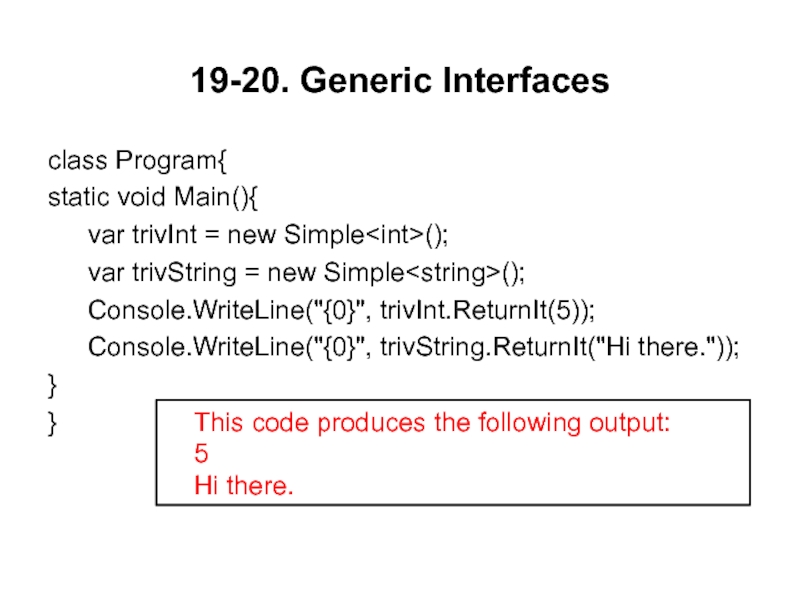
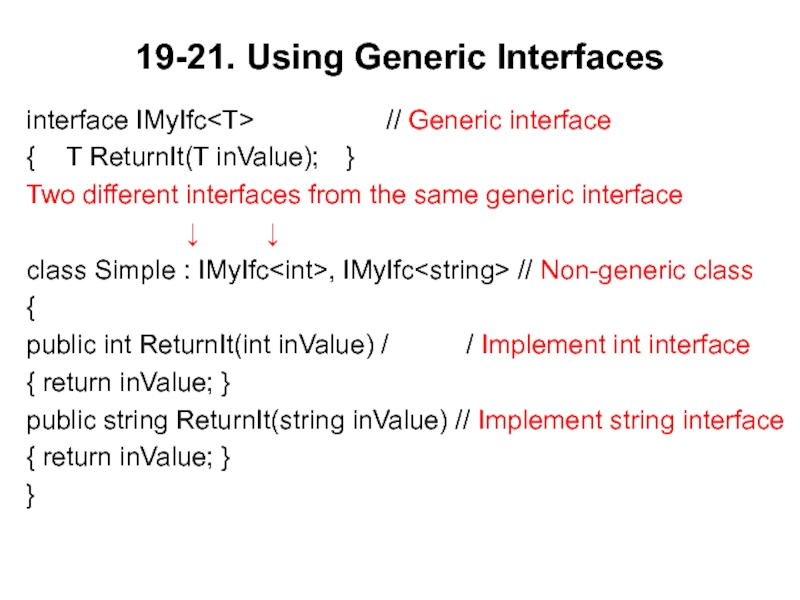
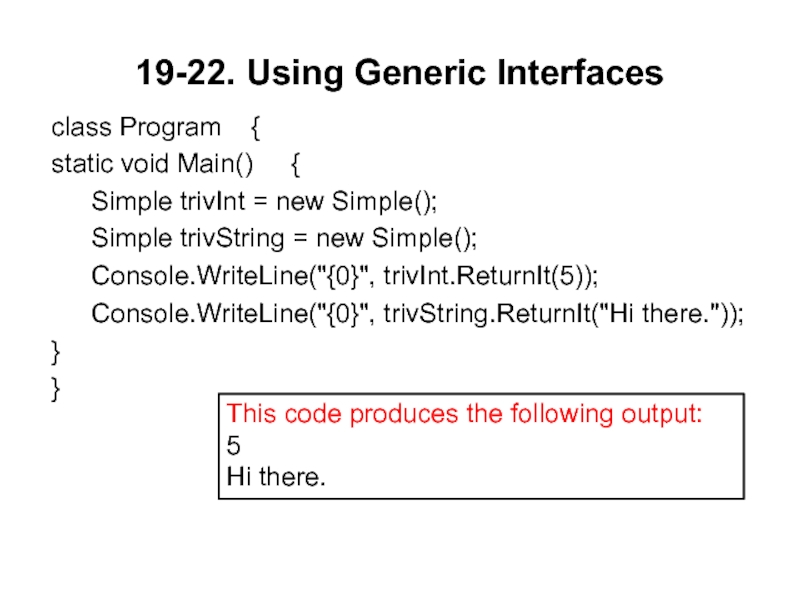
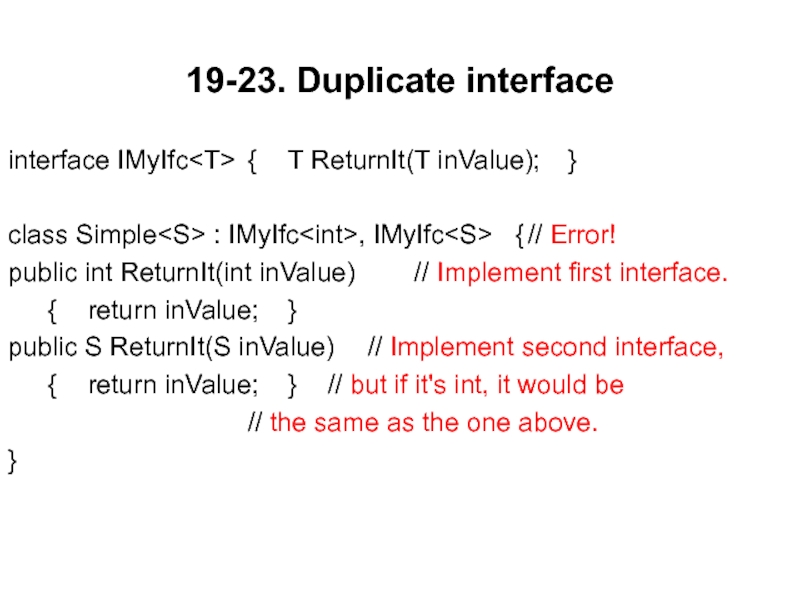
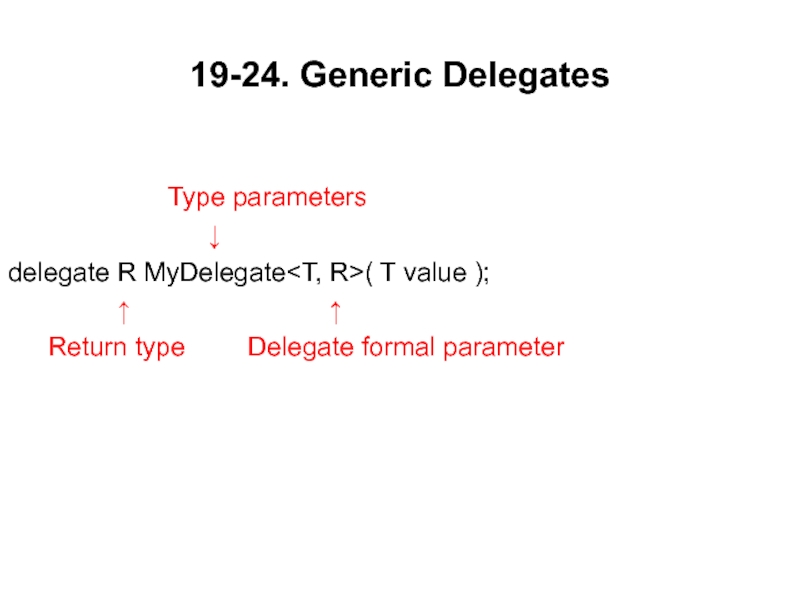
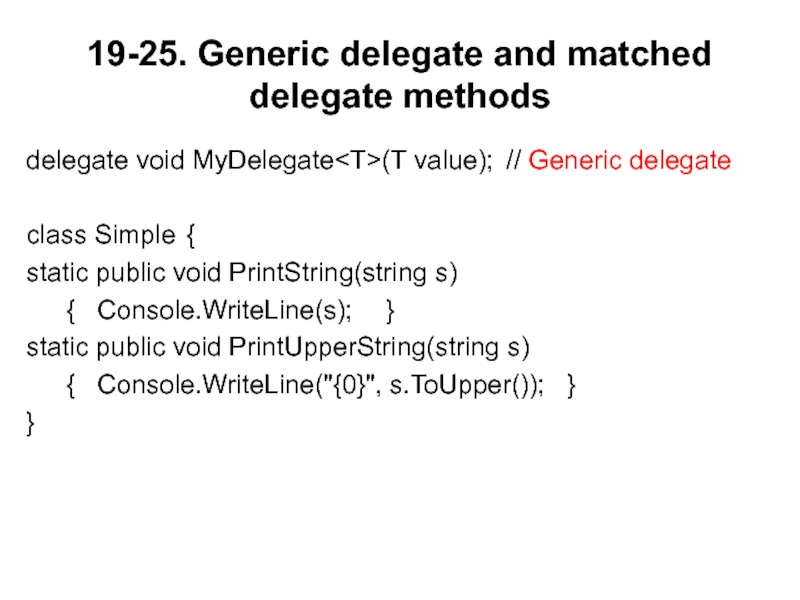
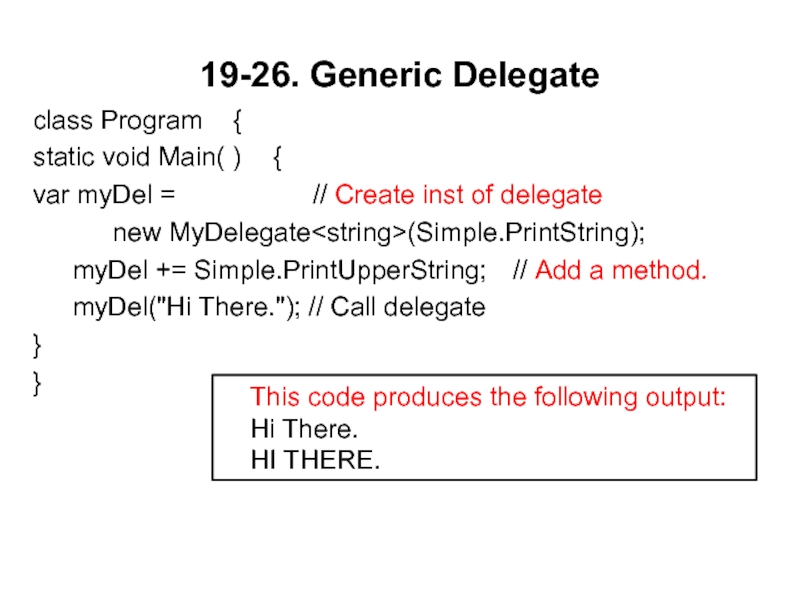
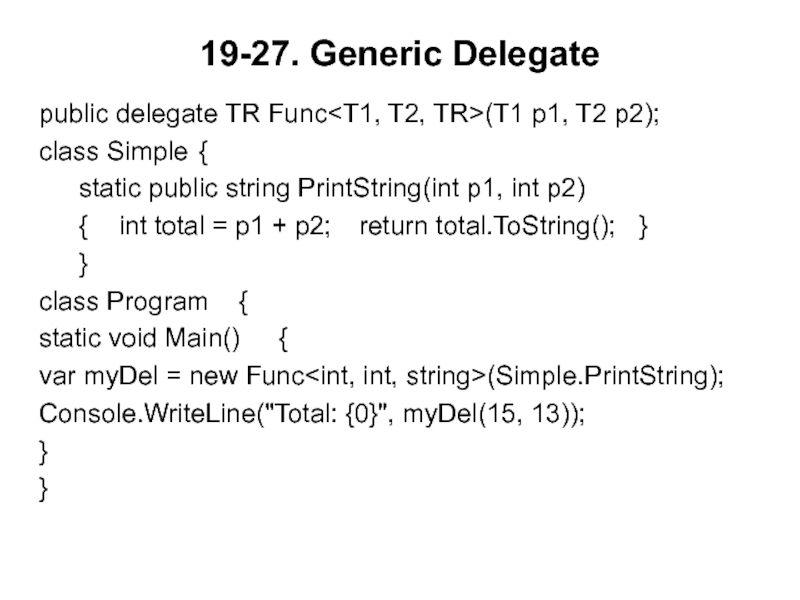
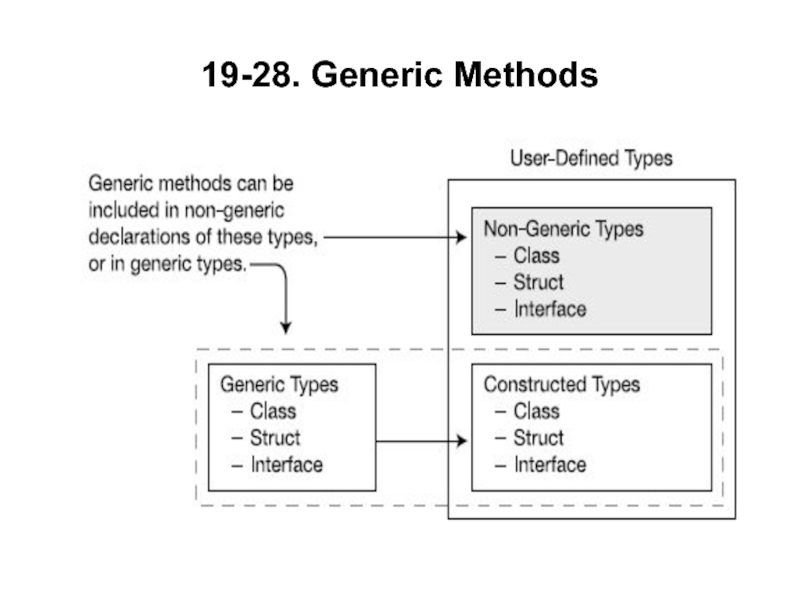
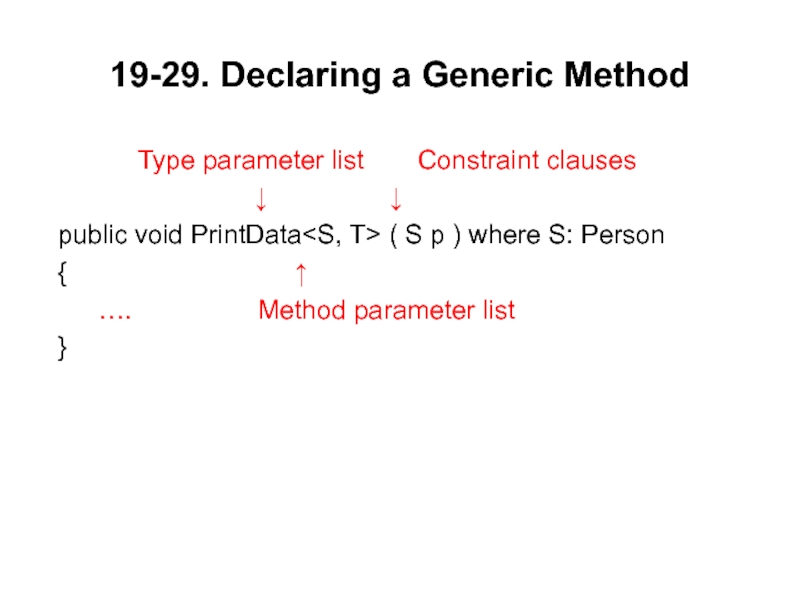
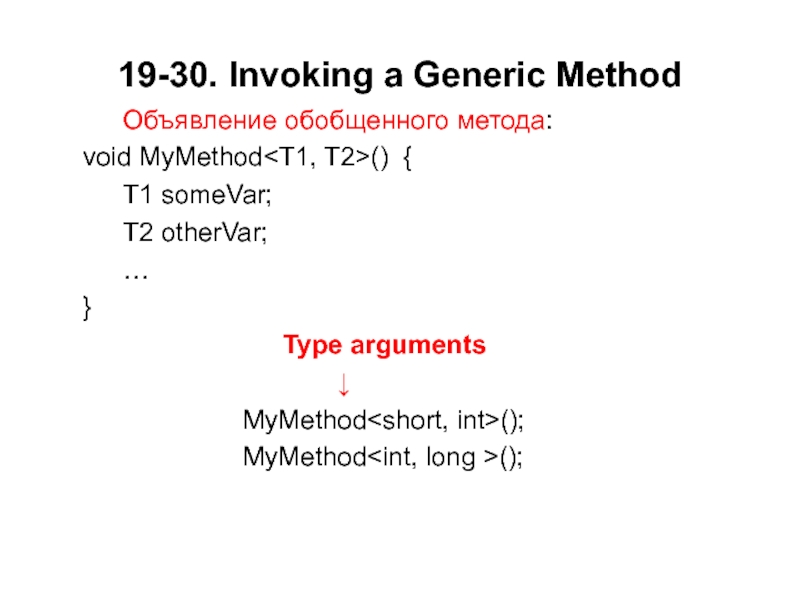
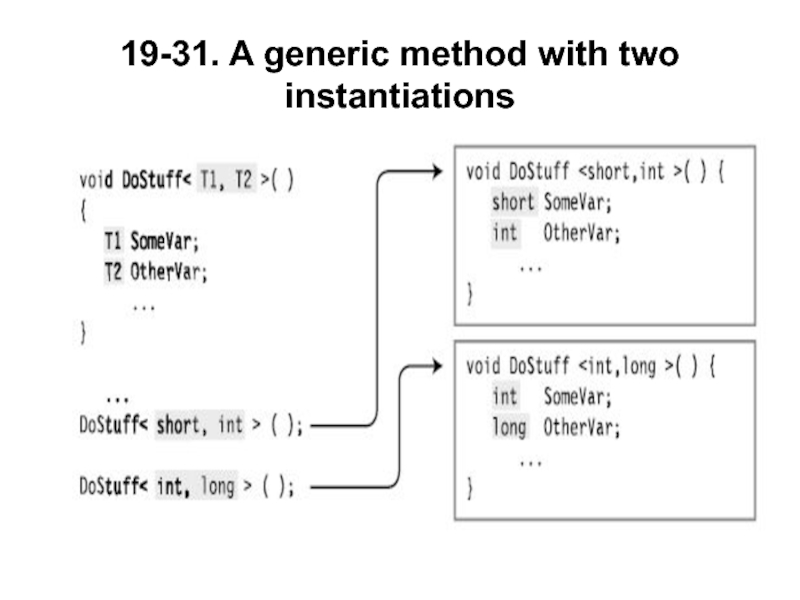
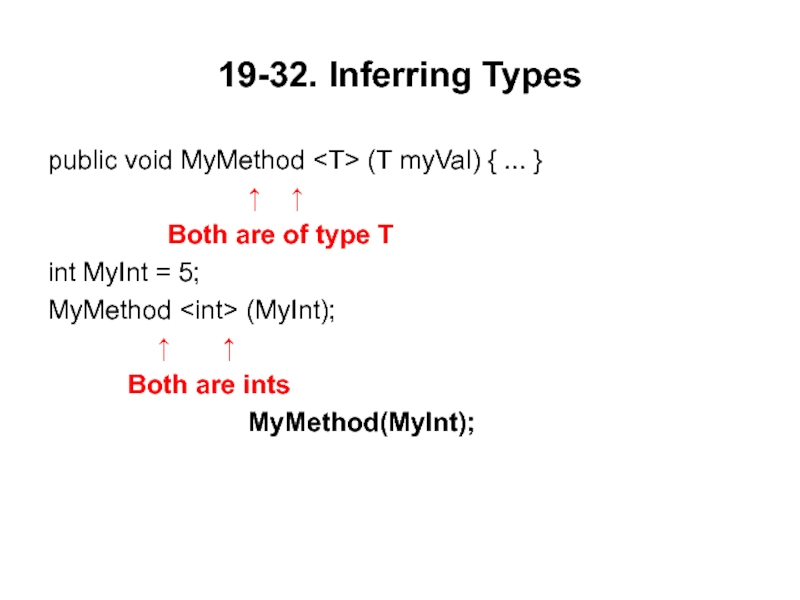
![В.В. Подбельский Иллюстрации к курсу лекций по дисциплине Программирование С 19-33. Example of a Generic Method class Simple { // Non-generic classstatic 19-33. Example of a Generic Method class Simple { // Non-generic classstatic public void ReverseAndPrint(T[] arr) // Generic](/img/thumbs/c4c55d29ff15fbabc575d0b1ff5ee133-800x.jpg)
![В.В. Подбельский Иллюстрации к курсу лекций по дисциплине Программирование С 19-34. Example of a Generic Method class Program {static void Main() { var intArray 19-34. Example of a Generic Method class Program {static void Main() { var intArray = new int[] { 3, 5,](/img/tmb/4/304364/bd566c150810d79fafde2f6b16b0d51a-800x.jpg)
![В.В. Подбельский Иллюстрации к курсу лекций по дисциплине Программирование С 19-35. Extension Methods with Generic Classes static class ExtendHolder {public static void 19-35. Extension Methods with Generic Classes static class ExtendHolder {public static void Print(this Holder h) { T[] vals =](/img/thumbs/21b234472942a851bd1f809d74a59b22-800x.jpg)
![В.В. Подбельский Иллюстрации к курсу лекций по дисциплине Программирование С 19-36. Exampleclass Program {static void Main(string[] args) { var intHolder = new Holder(3, 19-36. Exampleclass Program {static void Main(string[] args) { var intHolder = new Holder(3, 5, 7); var stringHolder = new Holder(](/img/thumbs/6deb802fc2d0f1e6cdc100e6a118c135-800x.jpg)













